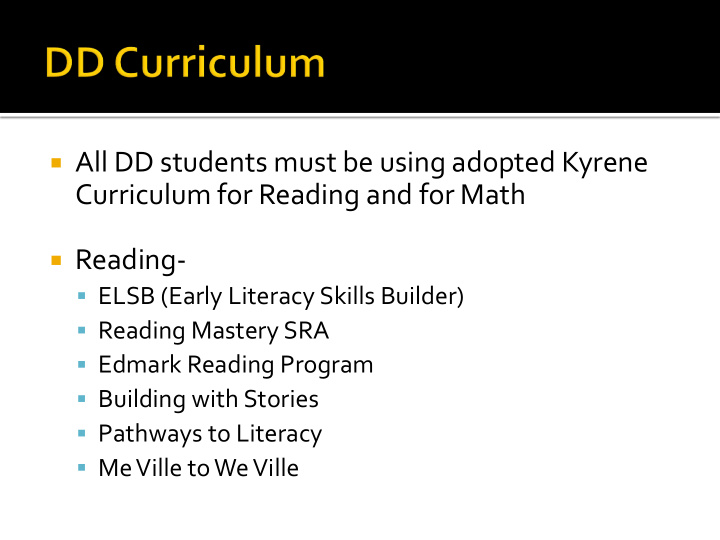



All DD students must be using adopted Kyrene Curriculum for Reading and for Math Reading- ELSB (Early Literacy Skills Builder) Reading Mastery SRA Edmark Reading Program Building with Stories Pathways to Literacy Me Ville to We Ville
Math ▪ Moving with Math Primary Connections Writing ▪ Step up to Writing Science and Social Studies ▪ Adopted from Kyrene Curriculum
Interactive puppet named “Moe” Building with Sounds and Symbols word and general print awareness 5 lessons each level 60 minutes/day; can be broken into (2) 30- minute sessions Building with Stories component Mastery level to proceed is a minimum of 75% score on level tests
1. Read sight words using time delay 2. Point to sight words to complete sentence 3. Point to text as it’s read 4. Say and/point to word to complete repeated story line 5. Respond to literal ? about a story 6. Syllable segmentation by clapping/tap/stomp
7. Understand phoneme segmentation by tapping out CVC words 8. Identify letter sound correspondences 9. First/ last sounds in words 10. Identify pictures begin with given sounds 11. Point to sounds in words 12. Blends sounds to identify pictures 13. Point to picture/word identify vocabulary 14. Use new vocabulary words to create a story
Lessons teach basic decoding and comprehension Decoding taught through words lists and stories- silent and aloud Comprehension activities include: answering questions about pictures, following directions, and responding to questions 1 st half- master decoding and comprehension 2 nd half- read stories , answer ?’s, and read irregular words
Group instruction- 20-30 minutes Independent work- 15- 20 minutes Work check- 5 minutes/ group Spelling (lessons 50-160)*
Carefully sequenced and highly repetitive Level One 150 basic sight words plus endings (-s, -ed, ing) Level Two 200 more words, plus compound words
Pre-Reading Visual discrimination Word Recognition Pairing spoken words with printed words Direction Cards Illustration cards to words to depict words/phrases Picture/Phrase Cards Word/phrase and sentence cards paired with simple illustrations of items, situations, or activities Story Book First ten words in a story format Tests Through out the program (pre and post)
Adapted stories for early literacy Ten storybooks for adapting Can be used with ELSB (Moe) or stand alone
Function of print print carries meaning Conventions of print There are rules Phonological awareness Syllables, rhymes and sounds in word Alphabetic knowledge Letters have sounds
Improve listening comprehension Develop vocabulary knowledge Improve communication Make decisions independently
A story based curriculum for early symbol users Five levels Upon completion users start ELSB
Beginning levels Relies on object use throughout the story to make it more concrete Objects paired with pictures and objects fade out Later Levels Pictures or symbols become focus All Levels Level mastery to move forward
Early literacy and communication curriculum Three Levels each with five sections New words, vocabulary activities, word wall words, literacy lessons, writing lessons Supports character education and social skills
Unit 1: ME Focus on individuality ▪ Lessons on Who I Am, How I Feel and What I Like Unit 2: My Family Focus on relationships ▪ Lessons on Who is in my family?, Things we do, Living with my family Unit 3: My School Focus on cooperation with classmates ▪ Lessons on Who is at my school?, Being a student, What we do
One-to-one correspondence- basis of counting Conservation of number Attributes of basic shapes Positional terms Attributes of measurement Combining and separating sets
Activity- based, language rich instructional model Standards- based learning and assessment system aligned to state/ national standards Prescreening- strengths and weaknesses Unit Reviews/ Unit Assessments- identify student mastery Skill Builder- additional instruction/ corrective action Oral Reviews- reinforce concepts Post Screening- end of program identify student needs (manipulative/paper/observation based)
Recommend
More recommend